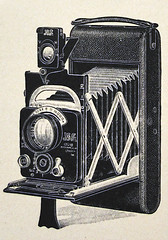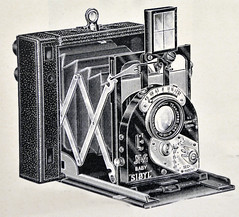Difference between revisions of "Sibyl"
(scan pool memberships all CP -> CW; image-author template & rights) |
(floated picture, with a margin) |
||
| (5 intermediate revisions by 2 users not shown) | |||
| Line 1: | Line 1: | ||
| − | The '''N&G Sibyl''' | + | <div class="floatright plainlinks" style="margin 0px 0px 20px 20px;"> |
| − | + | {{Flickr_image | |
| + | |image_source= http://www.flickr.com/photos/69559277@N04/15664988395/in/pool-camerawiki/ | ||
| + | |image= http://farm4.staticflickr.com/3942/15664988395_33558c9d1d.jpg | ||
| + | |image_align= right | ||
| + | |image_text= Newman & Guardia Sibyl Plate Camera | ||
| + | |image_by= Steve Given | ||
| + | |image_rights= with permission | ||
| + | }} | ||
| + | </div> | ||
| + | The '''N&G Sibyl''' is a strut folder with folding bed, made by [[Newman & Guardia]]. The example shown here has a Newton type finder. Others had [[brilliant finder]]s. This sample has a versatile shutter with seven speeds from 1/2 to 1/100 seconds. It has a [[Cooke]] 4.4inch f/6.5 lens (patents by H.D. Taylor). In the front end of the folding bed is a focusing lever to focus between 2 yards and infinity. In 1914 a 6.5x9cm variant and a quarter plate version were made and marketed as '''New Ideal Sibyl'''. The predecessing versions were ''ordinary, special and Imperial Sibyl''. Some of the cameras got a [[Protar]], a [[Tessar]] or the superb [[Ross Xpres]] lens. The '''Baby Sibyl''' is a smaller 4.5x6cm variant with [[Ross Xpres]] f/4.5 75mm plus alternate [[Dallmeyer]] Dallon Tele-[[Anastigmat]] 5.3 inch lens. The flagship was the '''Rangefinder Sibyl''' with coupled [[rangefinder (device)|rangefinder]]. Another variant was the '''Rollfilm Sibyl'''. The '''Sibyl Excelsior''' is an advanced [[rollfilm]] version with faster more reliable shutter. Film pack adapters were common accessories for these cameras. | ||
| + | {{br}} | ||
==Historic Illustrations== | ==Historic Illustrations== | ||
| Line 7: | Line 17: | ||
<center> | <center> | ||
{|class=plainlinks align="center" style="text-align: center;" | {|class=plainlinks align="center" style="text-align: center;" | ||
| − | + | |[http://www.flickr.com/photos/heritagefutures/4912593378/in/pool-camerawiki http://farm5.static.flickr.com/4118/4912593378_336a5b8351_m.jpg] | |
| − | + | |[http://www.flickr.com/photos/heritagefutures/4912031161/in/pool-camerawiki http://farm5.static.flickr.com/4115/4912031161_e8c41d4caf_m.jpg] | |
| − | + | |[http://www.flickr.com/photos/heritagefutures/4912636142/in/pool-camerawiki http://farm5.static.flickr.com/4094/4912636142_6784fb5897_m.jpg] | |
| − | + | |[http://www.flickr.com/photos/heritagefutures/4912580944/in/pool-camerawiki http://farm5.static.flickr.com/4099/4912580944_7eaede0e46_m.jpg] | |
|- | |- | ||
| colspan=3 | Historic advertisement. Details: Sybil Vitesse (left) and Sybil Excelsior (middle)<ref>Photograms of the Year 1932, p. 44</ref> | | colspan=3 | Historic advertisement. Details: Sybil Vitesse (left) and Sybil Excelsior (middle)<ref>Photograms of the Year 1932, p. 44</ref> | ||
| − | + | |Baby Sybil<ref>Photograms of the Year 1938, p 28</ref> | |
|- | |- | ||
|colspan=4 |<small>scans courtesy {{image author|Dirk HR Spennemann}}</small> {{public domain}} | |colspan=4 |<small>scans courtesy {{image author|Dirk HR Spennemann}}</small> {{public domain}} | ||
| Line 25: | Line 35: | ||
[[Category:UK]] | [[Category:UK]] | ||
[[Category:1911-1914]] | [[Category:1911-1914]] | ||
| + | [[Category:S]] | ||
Latest revision as of 09:34, 21 June 2019

|
| Newman & Guardia Sibyl Plate Camera image by Steve Given (Image rights) |
The N&G Sibyl is a strut folder with folding bed, made by Newman & Guardia. The example shown here has a Newton type finder. Others had brilliant finders. This sample has a versatile shutter with seven speeds from 1/2 to 1/100 seconds. It has a Cooke 4.4inch f/6.5 lens (patents by H.D. Taylor). In the front end of the folding bed is a focusing lever to focus between 2 yards and infinity. In 1914 a 6.5x9cm variant and a quarter plate version were made and marketed as New Ideal Sibyl. The predecessing versions were ordinary, special and Imperial Sibyl. Some of the cameras got a Protar, a Tessar or the superb Ross Xpres lens. The Baby Sibyl is a smaller 4.5x6cm variant with Ross Xpres f/4.5 75mm plus alternate Dallmeyer Dallon Tele-Anastigmat 5.3 inch lens. The flagship was the Rangefinder Sibyl with coupled rangefinder. Another variant was the Rollfilm Sibyl. The Sibyl Excelsior is an advanced rollfilm version with faster more reliable shutter. Film pack adapters were common accessories for these cameras.
Historic Illustrations

|

|

|

|
| Historic advertisement. Details: Sybil Vitesse (left) and Sybil Excelsior (middle)[1] | Baby Sybil[2] | ||
| scans courtesy Dirk HR Spennemann (Image rights) | |||